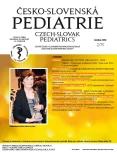Phenylketonuria: Inovative therapy with sapropterin
Authors:
R. Pazdírková; J. Komárková; M. Hedelová; J. David
Authors‘ workplace:
Klinika dětí a dorostu, Fakultní nemocnice Královské Vinohrady a 3. lékařská fakulta Univerzity Karlovy, Praha
Published in:
Čes-slov Pediat 2018; 73 (2): 84-88.
Category:
Original Papers
Věnováno významnému životnímu jubileu prof. MUDr. Lidky Lisé, DrSc.
Overview
Objective:
Sapropterin dihydrochlorid represents a new option of therapy for the part of patients with phenylketonuria/hyperphenylalaninemia (PKU/HPA). The efficiency of this synthetic form of cofactor tetrahydrobiopterin (BH4) depends on genotype and residual activity of the enzyme phenylalaninhydroxylase (PAH). The aim of the study was testing the selected patients for responsivity and allowing some of them to continue this new form of treatement.
Methods:
The study included 32 children, who were examinated by one-day or two-day BH4 test (dose 20 mg/kg/day of sapropterin). The measurement of phenylalanine (Phe) serum concentration was done at regular intervals. The test positivity was defined by the decrease in Phe serum concentration by the minimum of 30% of its original level.
Results:
In 15 children BH4 test was positive. The treatment using sapropterin had been gradually implemented for 11 children, at this time 6 of them continue the treatment. No side effects have been noted, concentrations of Phe are stable and mostly in therapeutic optimum. Two patients are entirely without diet, other patients under mild dietary restriction.
Conclusion:
The treatment using sapropterin is expensive, but it allows patients to return to ordinary life without limitation and risks associated with diet restriction and noncompliance.
Key words:
phenylketonuria, hyperphenylalaninemia, cofactor BH4, sapropterin, daily intake of phenylalanin
Sources
1. Blau N, van Spronsen FJ, Levy HL. Phenylketonuria. Lancet 2010; 376 (9750): 1417–1427.
2. Blau N, Hennermann JB, Langenbeck U, Lichter-Konecki U. Diagnosis, classification, and genetics of phenylketonuria and tetrahydrobiopterin (BH4) deficiencies. Mol Genet Metab 2011; 104: S2–9.
3. van Spronsen FJ, van Wegberg AM, Ahring K, et al. Key European guidelines for the diagnosis and management of patients with phenylketonuria. Lancet Diabetes Endocrinol 2017; 5 (9): 743–756.
4. Enns GM, Koch R, Brumm V, et al. Suboptimal outcomes in patients with PKU treated early with diet alone: revisiting the evidence. Mol Genet Metab 2010; 101: 99–109.
5. Moyle JJ, Fox AM, Arthur M, et al. Meta-analysis of neuropsychological symptoms of adolescents and adults with PKU. Neuropsychol 2007; 17: 91–101.
6. Jahja R, Huijbregts SCJ, de Sonneville LMJ, et al. Cognitive profile and mental health in adult phenylketonuria: A PKU-COBESO study. Neuropsychology 2017; 31 (4): 437–447.
7. Weglage J, Fromm J, van Teeffelen, et al. Neurocognitive functioning in adults with phenylketonuria: results of a long term study. Mol Genet Metab 2013; 110: S44–48.
8. MacDonald A, Gokmen-Ozel H, van Rijn M, Burgard P. The reality of dietary compliance in the management of phenylketonuria. J Inherit Metab 2010; 33 (6): 665–670.
9. Lee P, Treacy EP, Crombez E, et al. The Sapropterin Research Group, Safety and efficacy of 22 weeks of treatment with sapropterin dihydrochloride in patients with phenylketonuria. Am J Med Genet 2008; 146: 2851–2859.
10. Hennermann JB, Buhrer C, Blau N, et al. Long-term treatment with tetrahydrobiopterin increases phenylalanine tolerance in children with severe phenotype of phenylketonuria. Mol Genet Metab 2005; 86: S86–S90.
11. Keil S, Anjema K, van Spronsen FJ, et al. Long-term follow-up and outcome of phenylketonuria patients on sapropterin: a retrospective study. Pediatrics 2013; 131 (6): e1881–1888.
12. Burton BK, Grange DK, Milanowski A, et al. The response of patients with phenylketonuria and elevated serum phenylalanine to treatment with oral sapropterin dihydrochloride (6R-tetrahydrobiopterin): a Phase II, multicentre, open-label, screening study. J Inherit Metab Dis 2007; 30: 700–777.
13. Levy H, Milanowski A, Chakrapani A, et al. Efficacy of sapropterin dihydrochloride (tetrahydrobiopterin,6R-BH4) for reduction of phenylalanine concentration in patients with phenylketonuria: Phase III randomized placebo-controlled study. Lancet 2007; 370: 504–510.
14. Trefz FK, Burton BK, Longo N, et al. Efficacy of sapropterin dihydrochloride in increasing phenylalanine tolerance in children with phenylketonuria: Phase III, randomized, double-blind, placebo-controlled study. J Pediatr 2009; 154: 700–707.
15. Blau N, Bélanger-Quintana A, Mübeccel D, et al. Optimizing the use of sapropterin (BH4) in the management of phenylketonuria. Mol Genet Metab 2009; 96: 158–163.
Labels
Neonatology Paediatrics General practitioner for children and adolescentsArticle was published in
Czech-Slovak Pediatrics

2018 Issue 2
Most read in this issue
- Growth plate disorders causing familiar short stature
- Thyroglobulin and other laboratory diagnosis parameters in treating hypothyroidism in children
- ACTH dependent Cushing´s syndrome – case report
- Phenylketonuria: Inovative therapy with sapropterin
